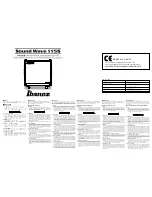
Microamplifier Series-Lead
Effects Preamp Turn-On Procedure
GK Document # 420-0063 –A
Model #’s: ML120E, ML260E- All options
Board #: 206-0063-E (ML/E preamp)
5/18/90 Rev.9/15/99-SW
NOTE: Italics refer to stereo power units.
SETUP
1)
Power switch off- Connect power cord.
2)
Connect power 3-pin connector from power amp to P1 on board. The colors should read (bottom-top): Black, Violet, and Brown. P1 is
closest to front.
3)
Connect signal 3-pin connector from power amp to P2 on board. The colors should read (bottom-top): White, Black, and Red. The colors
are clearly marked on the board for both connectors.
4)
Connect outputs to load box- left to load-A, right to load-B.
5)
Resistance loads open (switch in center).
6)
Load box to scope-B and AC-VM.
7)
Set scope switch on load box to look at load-A (down).
8)
Probe (1:1) to scope-A and DVM. (No gnd lead required.)
9)
Connect oscillator to input.
10) Oscillator on 100Hz sine wave @ 1.6Vrms (+4dBV).
11) DVM on 20V DC range.
12) AC-VM on 30V range.
13) Scope-A on 5V/cm, Scope-B on 10V/cm.
14) Scope sweep on 1ms/cm, trigger on A.
15) Boost, gain, lead master, shape, and output level to 0.
16) Clean volume, tones 10, all switches out.
17) Reverb, rate, and depth to 0.
INPUT SETUP AND LEAD CHANNEL TEST
1)
Turn on power switch- clean channel LED only should light.
2)
Engage channel switch- lead channel LED only should light.
3)
Look at U1/1 with probe. Adjust R5 (1k trim pot) until signal hits the rails on both sides evenly. Should be about 22Vp-p.
4)
Look at drain of Q50 (square pad-J113): +7.3Vdc.
5)
Adjust R67 for 4.0-4.5Vdc on drain of Q67 (J113).
6)
Adjust R87 for 5.8-6.2Vdc on drain of Q78 (J113).
7)
Increase gain to 10 and watch the signal become a square wave- it should clip evenly and reach about 9Vp-p.
8)
Decrease oscillator level to –66dBV (.5mVrms).
9)
Change DVM to AC (20V) scale.
10) Adjust R86 (50k trim) for 2.0Vac at drain of Q78.
CLEAN CHANNEL TEST
1)
Change scope-A to .5V/cm.
2)
Disengage channel switch so that the clean channel LED lights.
3)
Set oscillator to –46dBV (5mV) at 100Hz.
4)
Look at tip of send jack (J7) with probe: 0.47Vrms.
5)
Engage compressor. Send = 0.94Vrms. Disengage compressor. (Monitor both signals to make sure they are clean sine waves.
6)
Change scope trigger to B.
7)
With output level at 0, there should be no output. Gradually increase output level and it should hit the rails at about 1 o’clock and =
30Vrms.
8)
Flip scope switch to load B (up) and see that it also is 30Vrms and hits the rails at 1 o’clock on output level.
9)
Look at tip of headphone jack (J5) and continue increasing output level. Headphone output should be about 4.4Vrms with output level at
max (may not even hit rails with output all the way up).
10) Repeat 9) looking at ring of headphone jack.
TONE CONTROLS TEST
1)
Set front panel knobs to center (12 o’clock) except: boost, shape reverb, rate and depth to 0, gain to 10, switches out.
2)
Set scope-B to 2V/cm @1ms/cm.
3)
Set oscillator to 100Hz square wave at –46dBV.
4)
Look at output, compare to Fig. 1.



































